
17 minute read
A spoon full of care: conservation and packing for delicate sherbet spoons
Conservation of a four-panel screen at the Jeongjae Conservation Studio, Seoul
Susan Catcher, Senior Paper Conservator
Advertisement
Fig. 1 Embroidered silk panels showing the colour of both front and back and the original Korean green damask © Victoria and Albert Museum, London
In 1991, the Victoria and Albert Museum acquired four mounted scrolls (FE.29 to 32-1991) as a share of a donation made by Katherine Talati, a British painter of Indian (Parsee) heritage. Believed to date from the twentieth century, they once formed part of a folding screen (Jasu hwachogilsangmun byeongpung), which originally consisted of eight panels. The panels have a textile background, a cream, satin-weave silk, which is embroidered with recognizable flowers displayed in antique vases or pots. These flower arrangements alternate with auspicious Chinese characters. Each panel was mounted top and bottom with a Korean green silk damask and then framed with a floralpatterned silk brocade of Chinese origin. The backing paper was a burnished Chinese xuan zhi adhered to the first lining of Korean paper known as hanji. ¹ This backing was probably added later alongside the Chinese brocade when the panels were remounted as scrolls. On further checking it was discovered that the hanji lining of panel two (FE.32-1991) had Chinese calligraphy, written in black ink, that became apparent in transmitted light. The original rich yellow colour of the background silk was also revealed when the old linings were removed during conservation. Interestingly, the organic-dyed twisted silk threads of the embroidery were not badly faded (Fig. 1). These elegant floral designs would have been executed to a specific design using a paper template. Templates were drawn and numbered in relation to the screen panel sequence, which made identification of the order of the V&A panels as the first, second, seventh and eighth panels possible.2
During an assessment of these mounted panels with Dr. Rosalie Kim, curator of Korean Art, it was decided they could not be displayed in their current format. Culturally, the panels should be understood as part of a folding screen, albeit only having four of the eight original panels. Professor Park Chisun, a conservator of Korean art based in Seoul, was approached for expert advice on the remounting of these panels and suggested that it become an educational venture. Through various grants and the generosity of Professor Park, the author was invited to the Jeongjae Conservation Studio to join her team to recreate the four-panel screen.
Traditional materials and techniques have recently seen a resurgence in Korean conservation. In the past there had been a blurring of the lines between Chinese, Japanese and Korean materials. The similarities in style are partly due to the close geographical proximity and partly to historical ties. The Korean mounting technique had virtually disappeared for various reasons including colonial legacy and resulting wars. The evolution of paper making and silk weaving within each country gave rise to specific cultural norms. Research and publications have documented these distinctions and made them more accessible, which has led to improved communication and a willingness to understand the nuances of screen mounting. In the past these were not necessarily understood, especially by Western conservators, who through lack of access to specific materials and techniques had to rely on what was readily available – normally Japanese paper and mounting style. In recent years this has changed and part of the experience at the studio was to learn about the use of hanji paper, Korean hand-woven silk, and indigenous natural dyes to inform work on other Korean screens within the V&A collection.
The wooden core of the four-panel screen was constructed by a local carpenter using paulownia wood, a strong, even-grained, pale wood commonly used in Asia. The new latticed wooden panels were then covered with several layers of hanji, each paper layer having a slightly different purpose: alternating single sheets with a pocket layer rather
V&A Conservation Journal No.67 V&A Conservation Journal No.67
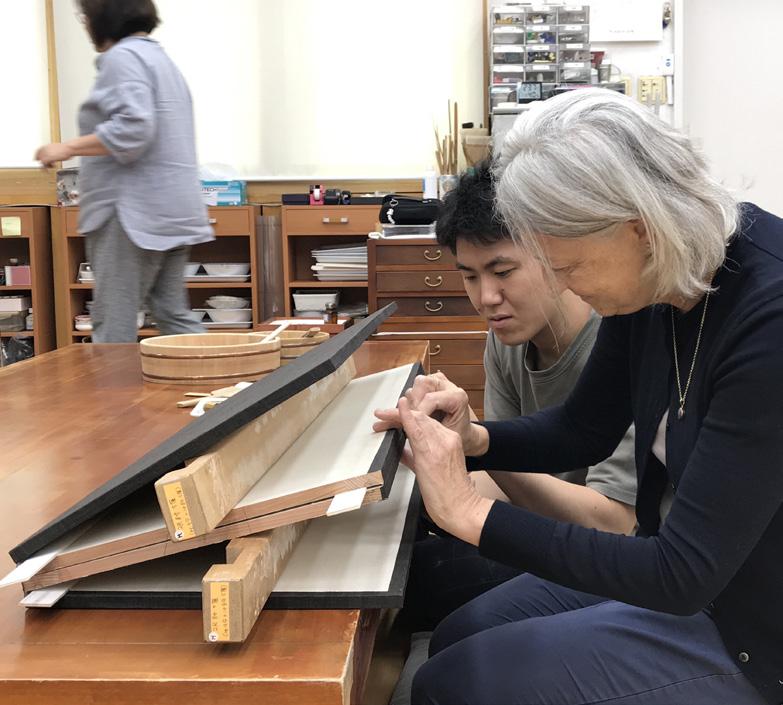
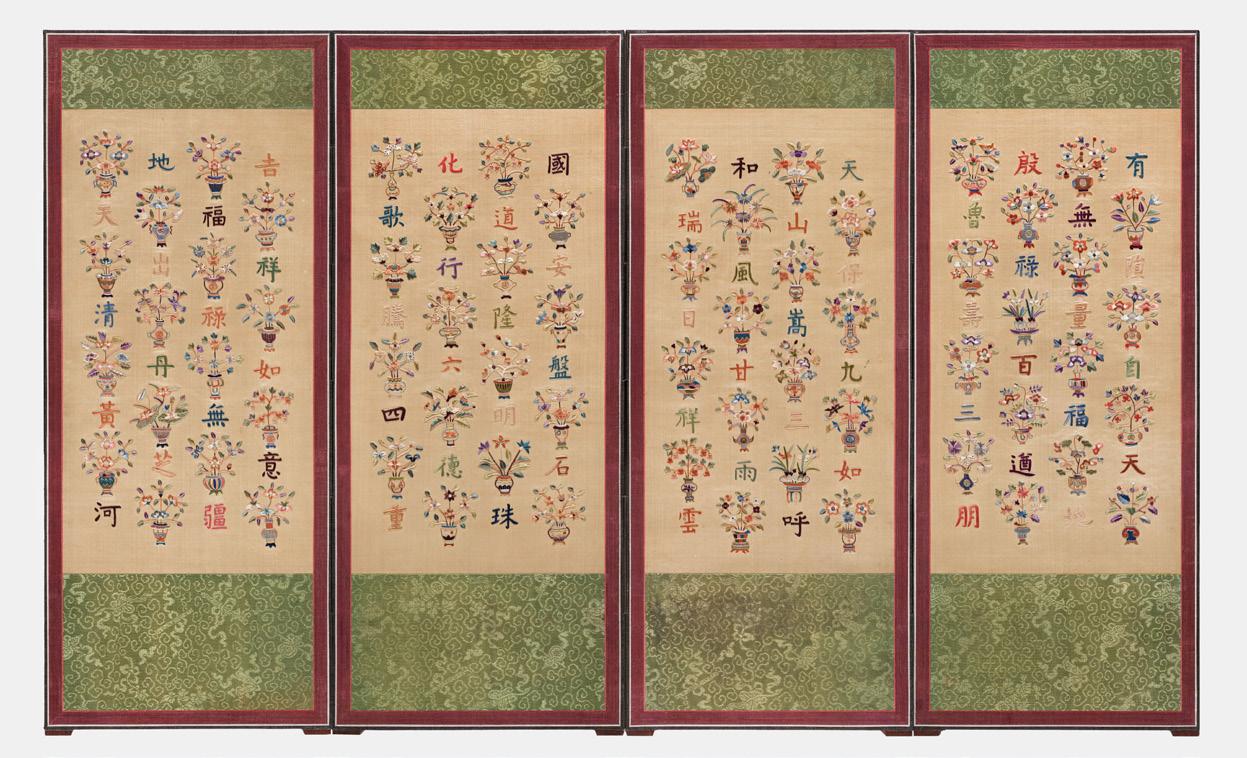
Fig. 2 The author and Hosung Won applying the dark blue linen textile to the hinges with Professor Park Chisun in the background at the Jeongjae Studio (Photograph courtesy of Overseas Korean Cultural Heritage Foundation) Fig. 4 The completed four-panel screen (Photograph courtesy of Overseas Korean Cultural Heritage Foundation)
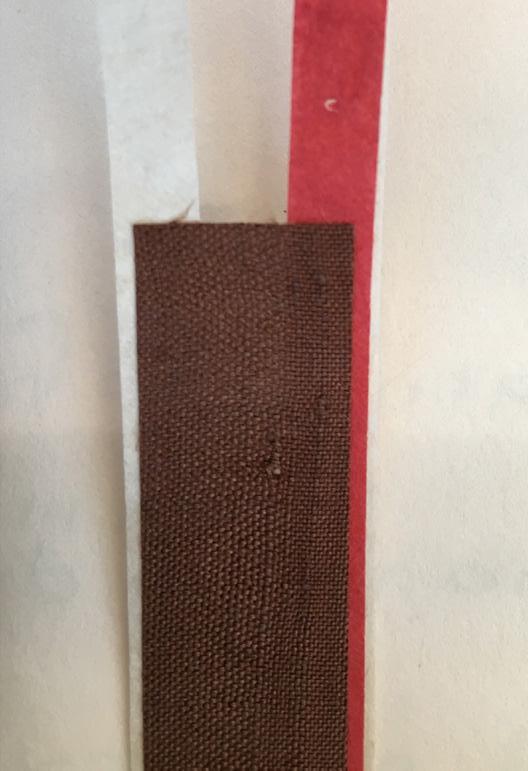
Fig. 3 Hand-made bands using natural dyed silk and paper strips to either side. These frame the panels at the final mounting stage © Victoria and Albert Museum, London
like a duvet creates a stable and cushioned surface for mounting the textile panels. The hinge attachment is complicated, and a small prototype was made in order to understand the alignment, measurements and application of the hinges (Fig. 2). After adhering with wheat starch paste, these were left to dry with weights to keep the structure perfectly square. Part of the unique mounting style of a Korean screen is the textile front and back cover, which is also used to cover the hinges. The coarse dark blue linen cloth is attached and left to dry (Fig. 3). Hand-made bands of silk and paper are used to frame the embroidered panels. Both are dyed using indigenous plant material, in this case, madder, alder cones and purple gromwell. The silk, which is hand woven in narrow strips, is washed and then dyed. This silk is scarce because the weavers are usually older women and are not being replaced by younger weavers. This problem is not unusual as Korean hanji production also has this succession issue.3
The finished screen was displayed in the exhibition Restoring the Legacy of Korean Paintings at the National Palace Museum of Korea in Seoul in September and October 2019. This exhibition highlighted the conservation of overseas Korean collections by Jeongjae studio with the support of the Overseas Korean Cultural Heritage Foundation (OKCHF). It was accompanied by the first International Symposium on the Conservation and Restoration of Overseas Korean Cultural Heritage, during which Professor Park and curators of Korean art from overseas museums, recipients of the OKCHF conservation grant, presented papers. The embroidery panels will be displayed for the first time, in their original form of a folding screen, in the Korean Gallery of the V&A from February 2020 onwards (Fig. 4).
Acknowledgments I am grateful to Professor Park Chisun and her team for sharing their expertise; to the Overseas Korean Cultural Heritage Foundation for supporting the conservation of these panels; and to The Plowden Trust for the grant that enabled me to travel to Seoul.
References 1. Lee A., Hanji Unfurled: One Journey into Korean
Papermaking, The Legacy Press 2012. 2. Kim, Rosalie, ‘Hwachogilsangmun embroidery panels in the Victoria and Albert Museum,’ in the 1st International
Symposium of Conservation and Restoration of Overseas
Korean Cultural Heritage. Restoring the Legacy of Korea
Paintings, eds. Cha Miae et. al. (Seoul: Overseas Korean
Cultural Heritage Foundation, 2019), 128-139. 3. Interview with Jang Seong Woo: https://www.youtube. com/watch?v=x7mPGaa_NMA
Clunie Fretton, Ornamental and Historic Woodcarver
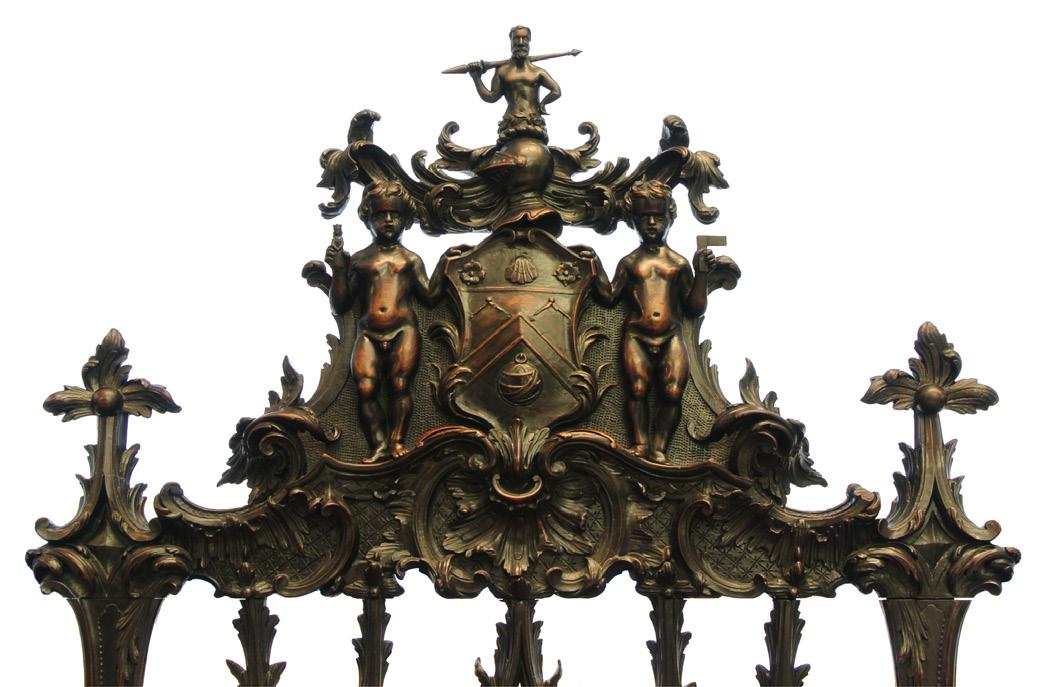
Fig. 1 The chair after restoration (Photography by author)
The restoration of the Master’s Chair of the Joiners & Ceilers Company posed an exciting challenge (Fig. 1). The chair, on long-term loan to the Victoria and Albert Museum, was made in 1754 by Edward Newman, a Past Master and talented cabinetmaker and carver, and gifted to the Company. It possesses carving and design of a distinctive flair and aptitude, and marries very elegantly the two concerns of the Joiners & Ceilers, who as a livery are responsible for both joinery and carving, the latter at times conflated with panellers under the archaic word “ceiler”. The chair, constructed from mahogany, has survived in remarkably good condition with very few significant losses from the ornately carved and pierced back despite its use. However, the apex of the chair back had more substantial losses, most notably the loss of a whole finial on the righthand side of the chair and a number of heraldic elements from the coat of arms figured in full relief in the middle.
It was particularly important to reduce the ambiguity of any replacements; a feat more easily achieved in the restoration of the missing leaf tips owing both to the predictability of acanthus as an ornamentation and also to the surplus of reference material in the carved chair back itself. The task was made easier by the hints left in the manner the carving had been undercut, as the decisions of the original carver left clues as to how the missing carving would have continued up from the breaks, so one could follow the curves to their conclusions. The missing finial could be copied directly from its mirror on the opposite side of the chair, barring a missing leaf tip at the top.
The replacement of the heraldic elements posed a greater challenge as there was the greatest lack of reference material. The content of the missing heraldry is defined very clearly in the blazon (a written description of the coat of arms that leaves no uncertainty as to the devices that are featured) but the execution of the missing elements was more problematic. However, research yielded a copy of Edward Hatton’s “New View of London”, published in 1708, which included descriptions of the Halls and Arms of every Livery Company and, most fortuitously, engravings of many of their coats of arms. Though published just under fifty years before the chair was made, this was the closest reference image that could be obtained of the coat of arms at that time, and the most contemporary blazon:
“Crest is a Demy-Savage proper holding a Spear Or. Supporters 2 Cupids of the last, the dexter holding a Woman crowned with a Castle, the sinister a Square.”
This thankfully cleared the muddied record of what the dexter supporter was holding, which had in some references been more akin to a figure of Christ, and clarified her as wearing a mural coronet. The crest, a “Savage”, was shown in the reference image holding a tilting spear.
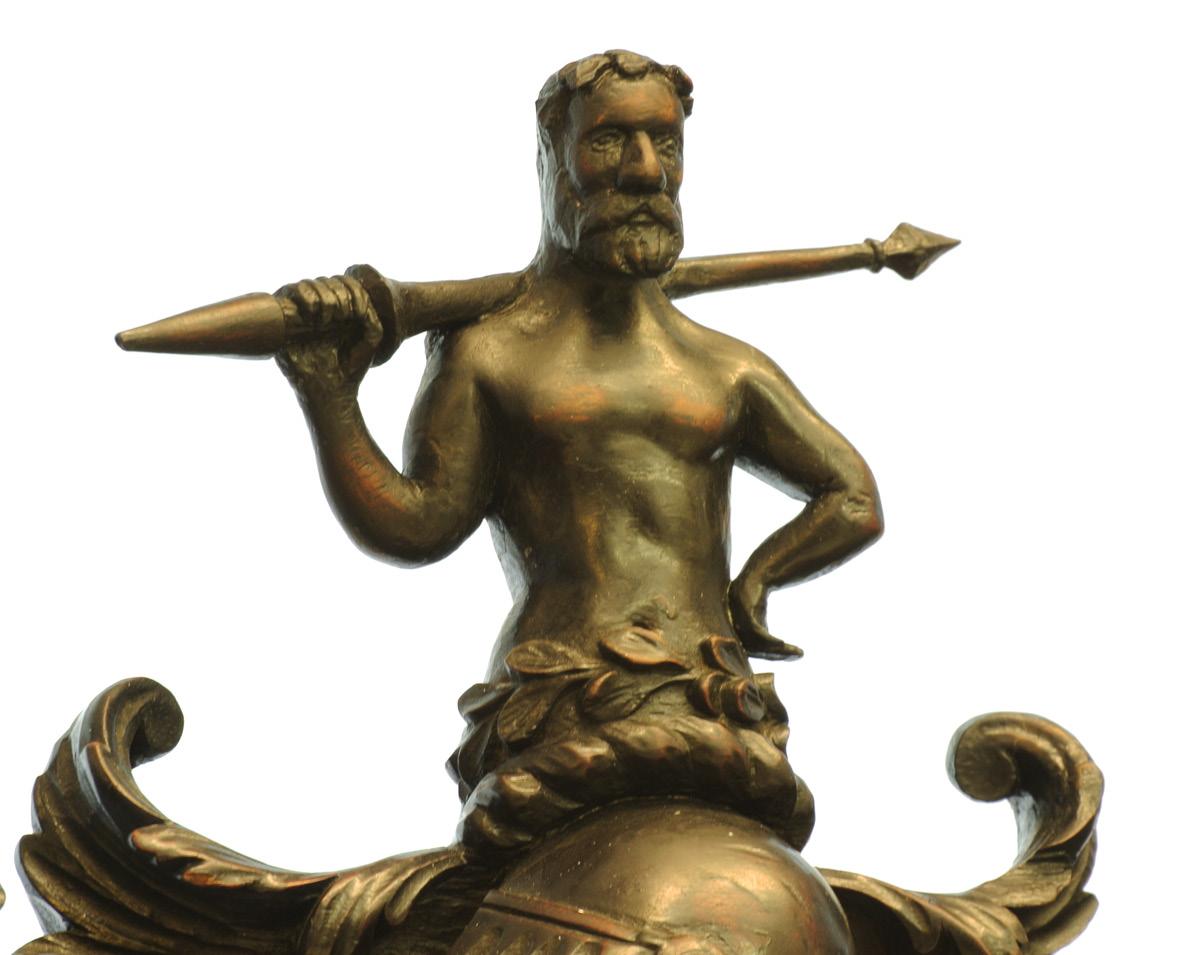
Fig. 2 Savage crest with left arm, spear and head restored (Photography by author) V&A Conservation Journal No.67 V&A Conservation Journal No.67
There were in total eleven missing pieces, comprising the arms from the supporters, an arm and head from the crest, the finial, and numerous leaf tips. Work began by modelling in a hard modelling wax, in order to create a removable reference for the new pieces being made and to fine-tune how best the new pieces ought to sit in relation to the old losses. Small blanks were then cut from Honduran mahogany, with the grain of the wood running in the same direction as on the original.
Carving began on elements attached to a piece of board with a hide-glue paper joint. This allowed the carving to be held in place and the majority of the waste material removed, while referencing the wax models prior to them being detached from the back board. With some excess material left, the carvings were then offered up to their positions, and the lengthy process of carving away their points of contact to match the often jagged and uneven breaks began. It was particularly important at this stage to have excess material left to allow the matching of contact points to be made exact before the rest of the carving was completed, so that on pieces such as the sinister supporter’s arm, the square would sit vertically and at the correct angle. At this stage the small size and awkward shape of the carving meant that it could no longer be fixed or clamped but held in one hand and carved with the other.
The carving of the head (Fig. 2) proved the greatest challenge due to the paucity of contemporary references. Inspiration was taken from the two supporters, which though carved with great facility also retained something of the uncanny in the proportions and shape of their faces. The broad foreheads and closely clustered features are typical of infants, but some of their unusual look was transposed into the head of the savage to create continuity with the existing carving style. The replacements were glued in place with hide glue bulked with coconut shell powder and microballoons. The clamping of the small and irregularly-sized pieces was tricky, and the best solution proved to be using Kemco Impression Compound pressed onto the new carvings in order to create a platform for the spring clamps (Fig. 3).
The chair had been French polished over the old breaks so the polish was removed as it would interfere with
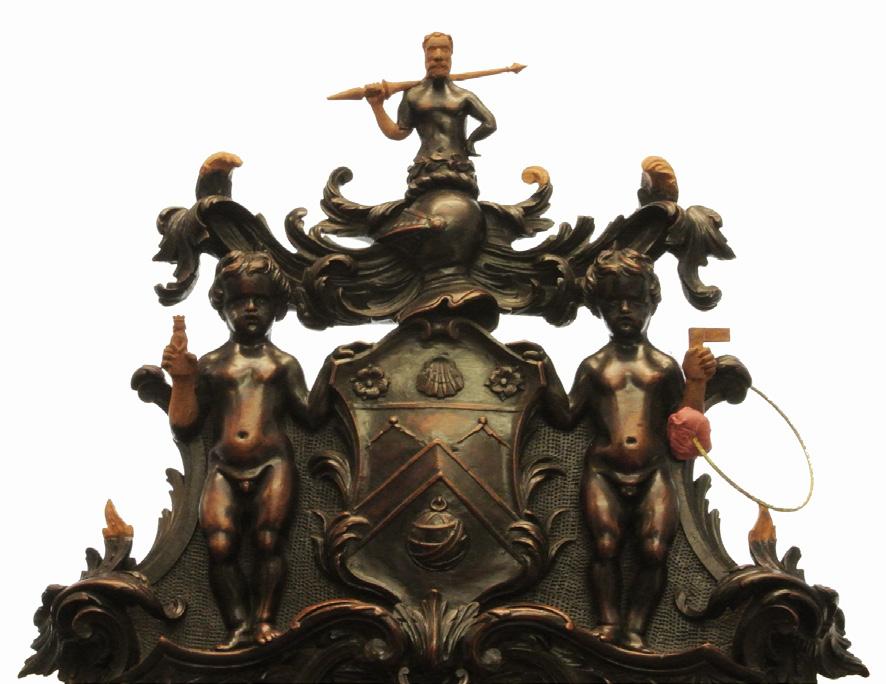
Fig. 3 Restoration in progress. Spring clamp and Kemco platform in use on the sinister supporter (Photography by author)
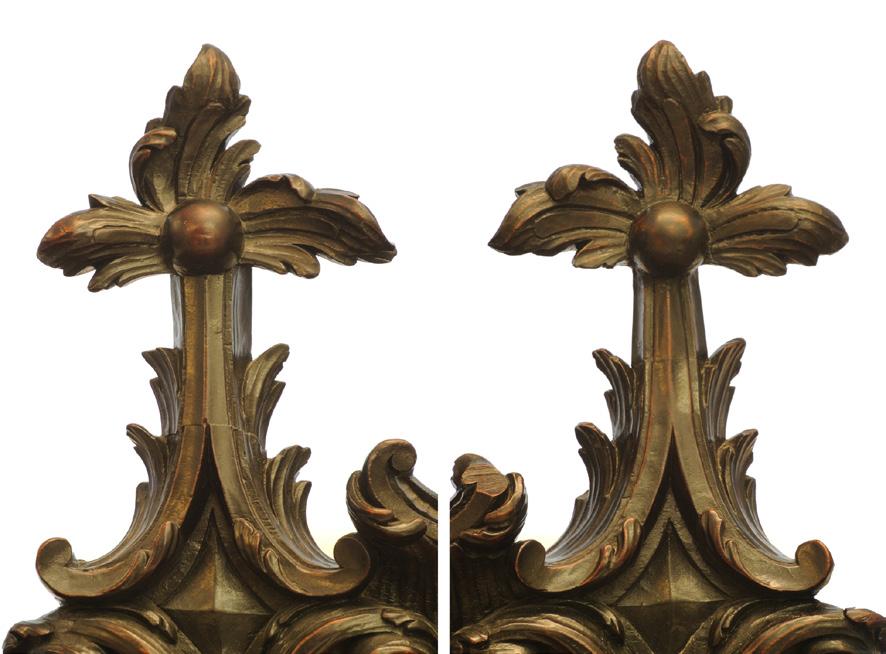
Fig. 4 Comparison of finials: original on the left, restoration on the right (Photography by author)
the adhesion of the glue. The carvings were then colour-matched to the original using garnet shellac, a close colour match, adjusted with a minute quantity of lamp black pigment. The carved additions were then rubbed back to be consistent with the wear on the original, and a small quantity of hard black wax was applied to smooth the joins where extensive wear of the breaks had rounded their edges (Fig. 4). Renaissance Wax was then applied to dull the sheen in areas inaccessible to sanding.
Acknowledgments I am grateful to the Worshipful Company of Joiners & Ceilers, curators Leela Meinertas and Nick Humphrey, and all the members of Furniture Conservation for their support during this project.
Urushi conservation at the V&A
Dana Melchar, Senior Furniture Conservator
Fig. 1 Raw, filtered urushi (Photography by Dana Melchar © Victoria and Albert Museum, London)

The Victoria and Albert Museum has a spectacular collection of Japanese lacquer, ranging from a samurai armour to tea caddies. Japanese lacquer, more accurately referred to as urushi, is made from the sap of the lacquer tree, toxidendron vernicifluum, native only to East Asia. The sap is unlike any artist material used outside of Asia; rather than hardening and drying through the familiar process of solvent evaporation, urushi polymerises in a damp environment. Another interesting, and not-to-be-forgotten fact: urushi is an allergen and can cause significant irritation if it comes into direct contact with skin prior to curing.
Urushi is naturally dark brown (Fig. 1). Unlike the yellowish, transparent, Western tree resins that can be dyed or pigmented a variety of colours, urushi historically had a limited range of possibilities; typically, either dark brown, black or red. Japanese urushi is often decorated using a technique known as maki-e, literally meaning ‘sprinkled picture’. Metal powders, of varying sizes and shapes, are sprinkled onto a wet urushi surface to create the design which can be flat or have a raised profile. Other materials can be used to decorate urushi, too, including: metal foils, seashell, eggshell, turtle shell and coral. When freshly cured, urushi is a strong material, impervious to damage by most substances. Exposure to light often causes the most damage to urushi and can lead to significant loss of sheen and to the maki-e decoration due to a breakdown of the urushi matrix on a microscopic level.
In the past and continuing to the present day, Western and Eastern approaches to the care of urushi objects has been very different. This may partially be due to the fact urushi has not been widely available in the West and therefore Western artisans have had little experience working with it. Historically, when urushi objects needed repair, often Western resins were used. Today, conservators and restorers continue to use familiar materials although they may, theoretically, have more possibility for reversibility. In Japan, the traditional materials used in making the object would have been used for treating damage along with other artistic materials available in Asia like cashew lacquer. With the development of the Art Conservation profession, which focuses on using reversible materials on objects, urushi (an irreversible material) was initially seen as an inappropriate material for conservation. In 2004 the V&A’s Mazarin Chest Project (funded by the Toshiba International Foundation, the Getty, and the V&A) brought a Japanese and Western conservator together to tackle the complex challenges of conserving a seventeenth-century urushi chest using a combination of both traditional Japanese materials and Western conservation materials. The 2004 project began to change Western perceptions and created new approaches in urushi

Fig. 2 Discussing practical projects (from left to right): Ms. Melchar, Ms. Sasaoka (interpreter), Mr. Omori (TIFO President), Mr. Tomoya Murose, Mr. Kazumi Murose (Photography by Dana Melchar © Victoria and Albert Museum, London) V&A Conservation Journal No.67 V&A Conservation Journal No.67
conservation (please see related V&A Conservation Journal publications about the Mazarin Chest project). Likewise, conservation principles have developed in Japan so that the focus of both traditions is now looking towards optimal preservation.
Since becoming the lead on conserving Japanese urushi at the V&A a few years ago, the author has received significant support to gain expertise in treating urushi from the V&A and the Toshiba International Foundation (TIFO). To further her understanding of urushi and Japanese approaches to conservation, an invitation was extended by Kazumi Murose, a Living National Treasure in Japan for maki-e, and Tomoya Murose, president of the Mejiro Institute for Urushi Conservation, to learn more in their Tokyo studio. Together with the President of TIFO, Mr. Keisuke Omori, they devised a two-part training programme over the course of two years for the author, directly relating to the types of treatments required to preserve the V&A’s urushi collection with the objective of enhancing the knowledge of Japanese urushi and practical conservation skills at the V&A (Fig. 2).
A team of ten conservators and artisans at the Mejiro Institute for Urushi provided instruction on various aspects of urushi conservation and maki-e decoration. The project aimed to increase the author’s practical conservation skills of urushi, especially focussing on cleaning and consolidation of foundation layers, and to further develop her understanding of maki-e

Fig. 3 Ms. Melchar using an urushi clay paste to repair damaged foundation layer (Photography by Dana Melchar © Victoria and Albert Museum, London)

Fig. 4 Ms. Melchar applying a fresh layer of urushi to a sample panel (Photography by Dana Melchar © Victoria and Albert Museum, London)
techniques. The training consisted of practical conservation treatments, learning maki-e techniques through making, as well as studying and discussing culturally significant urushi objects.
Most days in the studio were divided into practical conservation work and practising maki-e techniques. Treatment focussed on cleaning approaches, consolidating lifting lacquer with urushi, and learning more about the maki-e process by making two sample boards utilizing different maki-e decorative techniques (Figs. 3 and 4). In addition to the stated objectives, an opportunity was provided to study objects designated nationally as ‘Important Cultural Properties’ with the team and carry out a joint assessment. This was an insightful exercise of gauging preservation issues important to a Japanese audience and how they overlap with Western conservation ideals.
An interpreter, Keiko Sato, enabled meaningful conversations to take place with the Japanese team. Besides the professional exchanges, the author enjoyed learning more about Japanese culture from everyone in the studio. Exchanging perspectives on urushi, conservation, as well as philosophies, both professional and personal, illuminated motivations and values creating a sense of connectedness between everyone involved in the project.
As a result of this TIFO funded project, and the relationships at the Mejiro Institute of Urushi Conservation as well as TIFO, valuable experience and insight was gained during the project. Using urushi in conservation treatments and practising with using the material under the supervision of skilled practitioners has increased the author’s urushi skills and understanding, as well as of Japanese art and culture. It has directly informed and influenced practical treatment of objects within the V&A’s collection and future plans for urushi conservation at the V&A.



